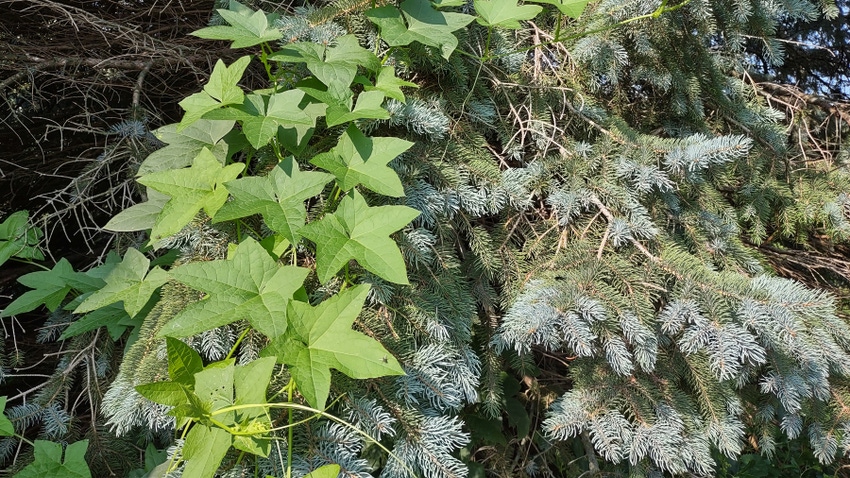
Will wild cucumbers kill my trees? If the tree is small, less than 3 or 4 feet in height, the answer is “yes.” Wild cucumber can engulf the small tree and pull it down under the weight of the vines. On larger trees, it may not kill the tree, but the aggressive vines definitely stress the tree, robbing it of sunlight.
Earlier in the year, no one thought we might be worrying this fall about plants that thrive in years with plentiful moisture. However, in many parts of the state, midsummer precipitation — following a very dry spring — has been quite welcome. But with that moisture, there are other challenges around the farm and garden, such as wild cucumber (Echinocystis lobata).
Steve Rasmussen, retired Nebraska Forest Service Northeast District forester, says that extra moisture can bring on this aggressive native plant that does best in low-lying, moist areas, woodlands and places where there is shade. But the vines can grow 25-30 feet tall, with tendrils that coil around anything they touch, including the branches of shelterbelt trees such as eastern red cedar, jack or Ponderosa pine and Colorado blue spruce, among others.
Is it a weed?
While most farmers consider it a weed when it engulfs shelterbelts and other trees and shrubs with vines, because it is so fast growing, wild cucumber has been used in landscape settings to cover a pergola, arbor, or fences and other structures. The yellow greenish-white flowers, Rasmussen says, are prolific and fragrant.
But this fast-growing annual is aggressive. It sprouts from seed in early summer, and once it blooms, it becomes more obvious. With star-shaped leaves that have five- to seven-pointed lobes, alternately placed along the stem, wild cucumber has seed pods that are oval and grow up to 2 inches in length. Just like cucumbers, they are covered in sharp spines, and when they are ripe, they open to disperse four flat spindle-shaped brown or black seeds, Rasmussen says.
That is key, because to control them, landowners will want to pluck off the seed pods before they mature so they don’t spread. Most likely, these aggressive plants will not kill your old stand shelterbelt trees, but they can be unsightly and, certainly, they don’t do the trees any favors by encompassing them in vines.
To control wild cucumber, Rasmussen suggests a few options:
If possible, pull or hoe the plants. This should be done early on, before the plants go to seed. The seedlings look exactly like garden cucumbers. You can mow the plants off in the early stages to keep them under control. If the vines have already taken over, pull them from the tree — perhaps with a pitchfork or tined fork — and pull them out of the ground and discard them. They are shallow-rooted and easily pulled. However, be sure to get them before they go to seed to reduce the potential for encroachment next season.
Use chemical control. Glyphosate can be used if it is carefully applied to the vine and not allowed to get on the green tissue of the trees or shrubs where the vines are growing. A 2% to 4% solution can be carefully, directionally applied around trees, because it is not absorbed by the roots or the bark. However, Rasmussen reminds landowners to keep glyphosate droplets off desired plants and trees, because it will kill anything that it touches. As always, read and follow directions on the label for chemical control.
About the Author(s)
You May Also Like






